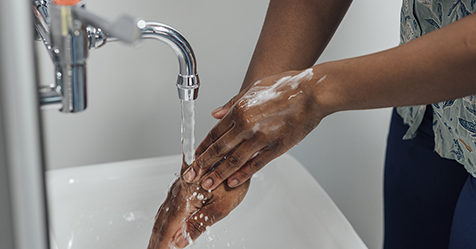School floors endure it all: thousands of footsteps daily, spills, scrapes from dragged furniture, and everything in between. Hard floor care isn’t just about cleaning—it’s a strategic system of plans, routines, and schedules that facility teams implement daily, weekly, monthly, and annually to keep floors looking their best and lasting as long as possible.
Floor care strategies have evolved significantly from decades-old buildings to modern campuses. Understanding each flooring type’s pros, cons, and maintenance needs is essential for a long-term, cost-effective strategy.
Hard floor types in schools
Three common hard floor types found in today’s schools are vinyl composite tile (VCT), polished concrete, and luxury vinyl tile (LVT). Each comes with its own strengths and challenges.
VCT is a staple in older school buildings, due in part to its affordability and familiarity among floor care and facility management teams. However, it’s a high-maintenance option that requires frequent cleaning, regular waxing, and a burnishing program. Foot traffic, desks, and chairs—especially those lacking proper floor glides—can easily scratch the wax surface, making it look dirty even after cleaning.
An advantage of VCT is the ability to customize its finish. You can apply different types of wax depending on the space’s use—for example, a harder wax in science labs for durability.
Polished concrete is an increasingly common choice for new schools and renovations. It doesn’t require waxing and is relatively easy to maintain if you keep up with regular dust mopping and auto-scrubbing. When cared for properly, polished concrete is durable and long-lasting. The natural variation of polished concrete results in a finish that isn’t always uniform; some may see this as a design benefit, and others may see it as a drawback. Concrete can also be stained to match school colors or branding.
The biggest polished concrete care concern is staining from spills left unattended for too long, but a consistent cleaning schedule helps minimize this risk.
LVT, the newest addition to school flooring, is more commonly seen in residential settings but is gaining traction in educational environments. It offers a stylish, home-like appearance and a softer feel underfoot compared to concrete.
While easier to maintain than VCT, performance varies by product. Some LVT types are incompatible with auto scrubbers, and the most frequent issue reported is separation at the seams where panels meet.
Common hard floor care challenges
Regardless of the floor type, schools face consistent floor care challenges driven by heavy, daily use. From morning to afternoon, classrooms, hallways, cafeterias, and multipurpose areas are
in near-constant use.
- Students and staff frequently drag desks and chairs, which can scuff and damage waxed surfaces like VCT.
- Sticky spills—especially colorful drinks like slushies or juice—can stain, especially on concrete, if left unattended.
- Shoes track in dust, gravel, water, and even ice melt in winter, adding grit that can grind into floor finishes.
These factors can wear down surfaces quickly, even with a solid floor care routine. A strong custodial program, consistent maintenance, and quick responses to messes are essential in keeping
floors in good condition.
Perhaps the most difficult challenge in school floor care is maintaining consistency year after year—especially regarding VCT. Skipping regular stripping and waxing might save time in the short term, but it often leads to major issues down the road. Repeatedly applying new layers of wax over old ones causes thick buildup that yellows, hardens, and becomes incredibly difficult to remove. It’s far more efficient—and cost-effective—to stick to a consistent annual maintenance routine than to defer the work and deal with larger restoration projects later.
Pro tips & best practices
The most crucial principle in floor care is consistency. Daily upkeep lays the foundation for long-term success. Start with the basics:
- Remove trash and debris.
- Spot mop and sweep regularly.
- Clean spills promptly.
For polished concrete and LVT, always follow manufacturer recommendations for cleaning methods and equipment to avoid damage.
For VCT, establish a set maintenance schedule that includes regular cleaning, consistent spot burnishing, and annual strip and wax cycles.
Always dust mop before using a scrubber on VCT floors. Skipping this step risks scratching the floor’s finish by grinding in dirt and debris with the scrubber, undoing hours of hard work. Regardless of the flooring material, a few best practices apply. When in doubt, manufacturer guidelines are the best resource. They outline exactly what tools and products are safe for each
surface. To avoid preventable damage and keep floors in top shape, it’s important to:
- Maintain floor equipment regularly so it performs reliably when needed.
- Use only approved cleaning chemicals and products specific to each floor type.
- Check scrubber pads to ensure they’re compatible with the flooring material and will not cause scratches.
Floor care in schools plays a vital role in creating safe, clean, and visually appealing environments for learning. Make sure you implement proper routines, use the right tools, and address issues early. Consistent care is key to maintaining floors that hold up to the daily demands of school life and also reflect the quality and pride of the space they support



